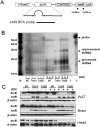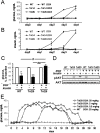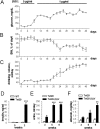Inducible transgenic rat model for diabetes mellitus based on shRNA-mediated gene knockdown
- PMID: 19340286
- PMCID: PMC2659743
- DOI: 10.1371/journal.pone.0005124
Inducible transgenic rat model for diabetes mellitus based on shRNA-mediated gene knockdown
Abstract
The rat is an important animal model in biomedical research, but gene targeting technology is not established for this species. Therefore, we aimed to produce transgenic knockdown rats using shRNA technology and pronuclear microinjection. To this purpose, we employed a tetracycline-inducible shRNA expression system targeting the insulin receptor (IR). Doxycycline (DOX) treatment of the resulting transgenic rats led to a dose-dependent and reversible increase in blood glucose caused by ubiquitous inhibition of IR expression and signalling. We could neither detect an interferon response nor disturbances in microRNA processing after DOX treatment excluding toxic effects of shRNA expression. Low dose DOX treatment induced a chronic state of diabetes mellitus. In conclusion, we have developed a technology which allows the specific, inducible, and reversible suppression of any gene of interest in the rat. Our first transgenic rat line generated with this method represents an inducible model for diabetes mellitus.
Conflict of interest statement
Figures




Similar articles
-
Inducible and reversible gene silencing by stable integration of an shRNA-encoding lentivirus in transgenic rats.Proc Natl Acad Sci U S A. 2008 Nov 25;105(47):18507-12. doi: 10.1073/pnas.0806213105. Epub 2008 Nov 18. Proc Natl Acad Sci U S A. 2008. PMID: 19017805 Free PMC article.
-
Developing tTA transgenic rats for inducible and reversible gene expression.Int J Biol Sci. 2009;5(2):171-81. doi: 10.7150/ijbs.5.171. Epub 2009 Jan 29. Int J Biol Sci. 2009. PMID: 19214245 Free PMC article.
-
Reversible gene knockdown in mice using a tight, inducible shRNA expression system.Nucleic Acids Res. 2007;35(7):e54. doi: 10.1093/nar/gkm122. Epub 2007 Mar 21. Nucleic Acids Res. 2007. PMID: 17376804 Free PMC article.
-
Tissue-specific insulin resistance in type 2 diabetes: lessons from gene-targeted mice.Ann Med. 2001 Feb;33(1):22-7. doi: 10.3109/07853890109002056. Ann Med. 2001. PMID: 11310935 Review.
-
Genetic engineering in mice: impact on insulin signalling and action.Biochem J. 1998 Oct 15;335 ( Pt 2)(Pt 2):193-204. doi: 10.1042/bj3350193. Biochem J. 1998. PMID: 9761714 Free PMC article. Review.
Cited by
-
RNA interference in pigs: comparison of RNAi test systems and expression vectors.Mol Biotechnol. 2011 May;48(1):38-48. doi: 10.1007/s12033-010-9346-6. Mol Biotechnol. 2011. PMID: 21057895
-
Continuous Blood Glucose Monitoring Reveals Enormous Circadian Variations in Pregnant Diabetic Rats.Front Endocrinol (Lausanne). 2018 May 29;9:271. doi: 10.3389/fendo.2018.00271. eCollection 2018. Front Endocrinol (Lausanne). 2018. PMID: 29896157 Free PMC article.
-
Impact of maternal hyperglycemia on cardiac development: Insights from animal models.Genesis. 2021 Nov;59(11):e23449. doi: 10.1002/dvg.23449. Epub 2021 Sep 9. Genesis. 2021. PMID: 34498806 Free PMC article. Review.
-
Accurate assessment of LV function using the first automated 2D-border detection algorithm for small animals - evaluation and application to models of LV dysfunction.Cardiovasc Ultrasound. 2019 Apr 22;17(1):7. doi: 10.1186/s12947-019-0156-0. Cardiovasc Ultrasound. 2019. PMID: 31010431 Free PMC article.
-
Effects of empagliflozin and target-organ damage in a novel rodent model of heart failure induced by combined hypertension and diabetes.Sci Rep. 2020 Aug 20;10(1):14061. doi: 10.1038/s41598-020-70708-5. Sci Rep. 2020. PMID: 32820187 Free PMC article.
References
-
- Aitman TJ, Critser JK, Cuppen E, Dominiczak AF, Fernandez XM, et al. Progress and prospects in rat genetics: a community view. Nat Genet. 2008;40:516–522. - PubMed
-
- Carmell MA, Zhang L, Conklin DS, Hannon GJ, Rosenquist TA. Germline transmission of RNAi in mice. Nat Struct Biol. 2003;10:91–92. - PubMed
-
- Saito Y, Yokota T, Mitani T, Ito K, Anzai M, et al. Transgenic small interfering RNA halts amyotrophic lateral sclerosis in a mouse model. J Biol Chem. 2005;280:42826–42830. - PubMed
-
- Buehr M, Meek S, Blair K, Yang J, Ure J, et al. Capture of authentic embryonic stem cells from rat blastocysts. Cell. 2008;135:1287–1298. - PubMed
Publication types
MeSH terms
Substances
LinkOut - more resources
Full Text Sources

